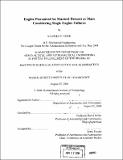Engine placement for manned descent at Mars considering single engine failures
Author(s)
York, Stephen P. (Stephen Patrick)
DownloadFull printable version (11.10Mb)
Other Contributors
Massachusetts Institute of Technology. Dept. of Aeronautics and Astronautics.
Advisor
David Miller.
Terms of use
Metadata
Show full item recordAbstract
Previous missions to Mars have landed masses of approximately I metric ton on the surface. Vehicles large enough to support humans on the flight to Mars and land them safely on the surface are closer to 100 metric tons, a two order of magnitude increase. This large mass causes many changes in the EDL of a manned vehicle compared to proven unmanned landers. One critical change is the potential choice of a propulsive descent to replace parachute systems that do not scale to large masses. The placement of these engines on a lander is subject to many concerns such as heat shield packing, cargo handling, and engine out mitigation. Engine out mitigation is of considerable interest because configurations that improve failure mitigation tend to be poorer for the other considerations. This thesis presents the development of a simulation of the descent phase of a manned landing at Mars, an overview of the effects of the various requirements on manned lander engine configuration and the results of a 6 DOF analysis of engine failure scenarios.
Description
Thesis (S.M.)--Massachusetts Institute of Technology, Dept. of Aeronautics and Astronautics, 2006. Includes bibliographical references (p. 93-94).
Date issued
2006Department
Massachusetts Institute of Technology. Department of Aeronautics and AstronauticsPublisher
Massachusetts Institute of Technology
Keywords
Aeronautics and Astronautics.